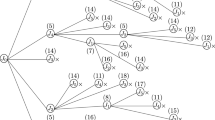Abstract
In this paper a problem of scheduling a single machine under linear deterioration which aims at minimizing the number of tardy jobs is considered. According to our assumption, processing time of each job is dependent on its starting time based on a linear function where all the jobs have the same deterioration rate. It is proved that the problem is NP-hard; hence a branch and bound procedure and a heuristic algorithm with O(n 2) is proposed where the heuristic one is utilized for obtaining the upper bound of the B&B procedure. Computational results for 1,800 sample problems demonstrate that the B&B method can solve problems with 28 jobs quickly and in some other groups larger problems are also solved. Generally, B&B method can optimally solve 85% of the samples which shows high performance of the proposed method. Also it is shown that the average value of the ratio of optimal solution to the heuristic algorithm result with the objective ∑(1 − Ui) is at most 1.11 which is more efficient in comparison to other proposed algorithms in related studies in the literature.
Similar content being viewed by others
References
Bachman A., Janiak A.: Minimizing maximum lateness under linear deterioration theory and methodology. Eur. J. Oper. Res. 126, 557–566 (2000)
Wang J.B., Wang L.Y., Wang D., Gao W.J.: Single-machine group scheduling with general linear deterioration to minimize the makespan. Int. J. Adv. Manuf. Technol. 43, 146–150 (2009)
Cheng T.C.E., Ding Q.: The complexity of scheduling starting time dependent tasks with release times. Inf. Proces. Lett. 65, 75–79 (1998)
Mosheiov G.: Scheduling jobs under simple linear deterioration. Comput. Oper. Res. 21, 653–659 (1994)
Cheng T.C.E., Ding Q., Lin B.M.T.: A concise survey of scheduling with time-dependent processing times. Eur. J. Oper. Res. 152, 1–13 (2004)
Gupta J.N.D., Gupta S.K.: Single facility scheduling with nonlinear processing times. Comput. Ind. Eng. 14, 387–393 (1988)
Lee W.C., Wu C.C., Chung Y.H.: Scheduling deteriorating jobs on a single machine with release times. Comput. Ind. Eng. 54, 441–452 (2008)
Wu C.C., Lee W.C.: Scheduling linear deteriorating jobs to minimize makespan with an availability constraint on a single machine. Inf. Proces. Lett. 87, 89–93 (2003)
Ji M., He Y., Cheng T.C.E.: Scheduling linear deteriorating jobs with an availability constraint on a single machine. Theor. Comput. Sci. 362, 115–126 (2006)
Browne S., Yechiali U.: Scheduling deteriorating jobs on a single processor. Comput. Oper. Res. 38, 495–498 (1990)
Bachman A., Janiak A.: Scheduling Jobs with Special Type of Start Time Dependent Processing Times. Institute of Engineering Cybernetics. Wroclaw University of Technology, Wroclaw (1997)
Hsu Y.S., Lin B.M.T.: Minimization of maximum lateness under linear deterioration. Omega 31, 459–469 (2003)
Bachman A., Janiak A., Kovalyov M.Y.: Minimizing the total weighted completion time of deteriorating jobs. Inf. Proces. Lett. 81, 81–84 (2002)
Moslehi G., Jafari A.: Minimizing the number of tardy jobs under piecewise-linear deterioration. Comput. Ind. Eng. 59, 573–584 (2010)
Lai, P., Wu, C., Lee, W.: Single machine scheduling with logarithm deterioration. Optim. Lett. (2011). doi:10.1007/s11590-011-0362-7
Lee C., Yu G.: Parallel machine scheduling under potential disruption. Optim. Lett. 2, 27–37 (2008)
M’Hallah R., Bulfin R.L.: Minimizing the weighted number of tardy jobs on a single machine with release dates. Eur. J. Oper. Res. 176, 727–744 (2007)
Peres S.D., Sevaux M.: An exact method to minimize the number of tardy jobs in single machine scheduling. J. Sched. 7, 405–420 (2004)
Bulfin R.L., M’Hallah R.: Minimizing the weighted number of tardy jobs on a two-machine flowshop. Comput. Oper. Res. 30, 1887–1900 (2003)
M’Hallah R., Bulfin R.L.: Minimizing the weighted number of tardy jobs on a single machine. Eur. J. Oper. Res. 145, 45–56 (2003)
Chen W.J.: Minimizing number of tardy jobs on a single machine subject to periodic maintenance. Omega 37, 591–599 (2009)
Brucker P.: Scheduling Algorithm, 5th edn. Springer Publishing Company, New York (2006)
Author information
Authors and Affiliations
Corresponding author
Rights and permissions
About this article
Cite this article
Jafari, A., Moslehi, G. Scheduling linear deteriorating jobs to minimize the number of tardy jobs. J Glob Optim 54, 389–404 (2012). https://doi.org/10.1007/s10898-011-9767-1
Received:
Accepted:
Published:
Issue Date:
DOI: https://doi.org/10.1007/s10898-011-9767-1




